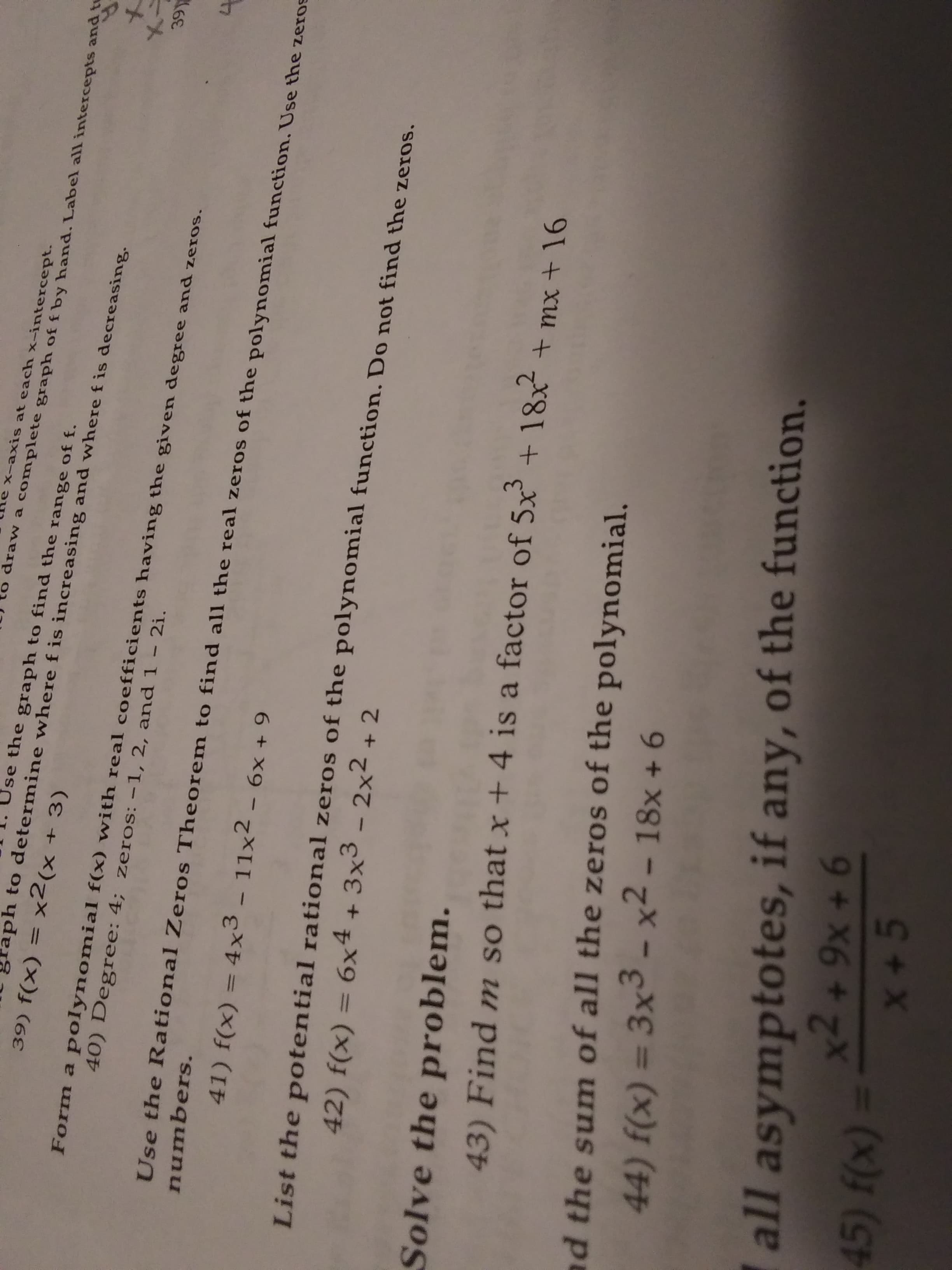X-axis at each x-intercept. araw a complete graph of f by hand. Label all intercepts and t Jse the graph to find the range of f. ph to determine where f is increasing and where f is decreasing. 39) f(x) = x2(x + 3) %3D Form a polynomial f(x) with real coefficients having the given degree and zeros. 40) Degree: 4; zeros: -1, 2, and 1- 2i. Use the Rational Zeros Theorem to find all the real zeros of the polynomial function. Use the zeros numbers. 41) f(x) = 4x3 - 11x² - 6x + 9 %3D List the potential rational zeros of the polynomial function. Do not find the zeros. 42) f(x) = 6x4 + 3x³ - 2x2 + 2 Solve the problem. 43) Find m so that x+4 is a factor of 5x³ + 18x + mx + 16 ad the sum of all the zeros of the polynomial. 44) f(x) = 3x3 - x2 - 18x + 6 all asymptotes, if any, of the function. x2 + 9x + 6 (x) ) x+5
X-axis at each x-intercept. araw a complete graph of f by hand. Label all intercepts and t Jse the graph to find the range of f. ph to determine where f is increasing and where f is decreasing. 39) f(x) = x2(x + 3) %3D Form a polynomial f(x) with real coefficients having the given degree and zeros. 40) Degree: 4; zeros: -1, 2, and 1- 2i. Use the Rational Zeros Theorem to find all the real zeros of the polynomial function. Use the zeros numbers. 41) f(x) = 4x3 - 11x² - 6x + 9 %3D List the potential rational zeros of the polynomial function. Do not find the zeros. 42) f(x) = 6x4 + 3x³ - 2x2 + 2 Solve the problem. 43) Find m so that x+4 is a factor of 5x³ + 18x + mx + 16 ad the sum of all the zeros of the polynomial. 44) f(x) = 3x3 - x2 - 18x + 6 all asymptotes, if any, of the function. x2 + 9x + 6 (x) ) x+5
Algebra & Trigonometry with Analytic Geometry
13th Edition
ISBN:9781133382119
Author:Swokowski
Publisher:Swokowski
Chapter4: Polynomial And Rational Functions
Section4.5: Rational Functions
Problem 54E
Related questions
Question
Find m so that x+4 is a factor of 5x3 + 18x2+mx+16

Transcribed Image Text:X-axis at each x-intercept.
araw a complete graph of f by hand. Label all intercepts and t
Jse the graph to find the range of f.
ph to determine where f is increasing and where f is decreasing.
39) f(x) = x2(x + 3)
%3D
Form a polynomial f(x) with real coefficients having the given degree and zeros.
40) Degree: 4; zeros: -1, 2, and 1- 2i.
Use the Rational Zeros Theorem to find all the real zeros of the polynomial function. Use the zeros
numbers.
41) f(x) = 4x3 - 11x² - 6x + 9
%3D
List the potential rational zeros of the polynomial function. Do not find the zeros.
42) f(x) = 6x4 + 3x³ - 2x2 + 2
Solve the problem.
43) Find m so that x+4 is a factor of 5x³ + 18x + mx + 16
ad the sum of all the zeros of the polynomial.
44) f(x) = 3x3 - x2 - 18x + 6
all asymptotes, if any, of the function.
x2 + 9x + 6
(x) )
x+5
Expert Solution
This question has been solved!
Explore an expertly crafted, step-by-step solution for a thorough understanding of key concepts.
This is a popular solution!
Trending now
This is a popular solution!
Step by step
Solved in 3 steps with 3 images

Knowledge Booster
Learn more about
Need a deep-dive on the concept behind this application? Look no further. Learn more about this topic, algebra and related others by exploring similar questions and additional content below.Recommended textbooks for you

Algebra & Trigonometry with Analytic Geometry
Algebra
ISBN:
9781133382119
Author:
Swokowski
Publisher:
Cengage

Algebra & Trigonometry with Analytic Geometry
Algebra
ISBN:
9781133382119
Author:
Swokowski
Publisher:
Cengage